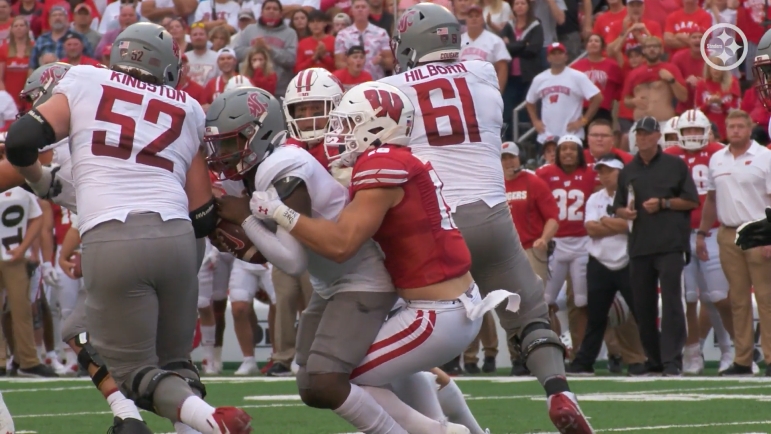The Pittsburgh Steelers selected Wisconsin LB Nick Herbig in the fourth round of the 2023 NFL Draft, reuniting him with his older brother, OG Nate Herbig, in Pittsburgh. Herbig was an extremely productive player during his time with the Badgers, playing most of his time at OLB on the edge where he starred as a pass rusher chasing after QBs. Herbig amassed 36 tackles for loss and 21.0 career sacks, including 11.0 sacks as a senior in 2022, showing a real knack of getting after the passer.
While the coaches have said they intend to start Herbig at OLB in hopes of providing quality depth behind T.J. Watt and Alex Highsmith, one facet of his game could be a deterrent to Herbig sticking as a full-time edge rusher: run defense.
Josh Carney of Steelers Depot recently wrote a piece stating why keeping Herbig at OLB would be a mistake, listing his ideal lack of size and arm length as reasons why he may struggle setting the edge against the run. I decided to dive deeper into Herbig’s run defense, highlighting both the positives and negatives to project how he will hold up at the next level.
The Film
When you plug in the tape on Herbig, the first thing that stands out is the guy’s motor. He plays with relentless effort on nearly every snap as a pass rusher as well as in pursuit of the ball carrier against the run. You see that effort in this play where Herbig comes off free in backside pursuit, making the tackle for loss against Northwestern.
Herbig also can be slippery for blockers to get a hold of given his smaller stature and his athleticism to knife though gaps in pursuit of the football. Here is a good example of this against Michigan State backed up on its own goal line. Crossing the face of the tight end, Herbig knifes into the backfield and makes the tackle right at the LOS.
We see a similar play here against Ohio State. Herbig gets low and loops around RT Dawand Jones, working back inside to tackle the runner before he can reach the first-down marker.
Herbig has a fair amount of play strength and can execute the push/pull move on TEs and smaller OTs to get off blocks when setting the edge against the run. Watch this rep against Iowa. Herbig strings out the run toward the sideline and rips off the block as the runner attempts to get to the outside, making the tackle in the backfield for a loss.
While Herbig gives great effort as a run defender, there are many occasions where his lack of size and length lead to him getting manhandled by bigger, stronger blockers at the point of attack. As Josh Carney pointed out in his article above, Herbig checked in to the Combine at 6’2, 240lb with 31 1/4″ arms, coming in at the 54th percentile for weight, 68th percentile for height, 18th percentile for arm length and 21st percentile for hand size, according to mockdraftable.com.
That lack of length and overall size shows up when having to set the edge and fight off bigger OTs that have the long arms to stonewall Herbig at the LOS, neutralizing him from getting in on the play. Here are a couple examples against Ohio State where Jones engulfs Herbig right after the snap, using his size and long arms to get first contact on Herbig, who is unable to get off the block and make a play on the runner.
Herbig’s lack of size also leads to him getting pushed off his spot a lot easier on base blocks by OTs or on combo blocks like the example you see below. Sure, it’s difficult for any defender to fight off a double team to make a play, but Herbig is unable to fight pressure as he gets walled off from the ball, having the blockers create a seal for the runner to pick up the first down.
Another negative that sticks out in Herbig’s game as a run defender is his lack of balance when coming in to make a tackle. You see him slip a fair amount on the field when attempting to quickly change directions or evade blockers. This lack of balance also can lead to missed tackles like we see in the clip below against Michigan State. Herbig plays with his shoulder pads over his toes and makes the grave mistake of ducking his head and taking his eyes off the ball carrier, leading to the whiffed tackle attempt.
Conclusion
Nick Herbig plays with impressive effort as a run defender and can use his lack of size as a tool to maneuver around and through blocks in his pursuit of the ballcarrier. However, that lack of ideal size, mass, and length also can be his greatest liability as a run defender, causing him to struggle at setting the edge against bigger, longer blockers that can neutralize him with a size advantage. Herbig’s best bet to stick out on the edge is to add another five-plus pounds to better set the edge while relying on his quickness and pass rush prowess as a sub package rusher to be enough for Pittsburgh to feel comfortable keeping him out there.
Still, a move to the box may be in the best interests of Herbig as well as the Steelers if he desires to become more than an 8-10 snap a game contributor on defense while providing quality play on special teams. He can mask some of his issues with his run defense thanks to his athleticism and effort, but his lack of ideal measurables will likely prevent him from being a reliable three-down defender out on the edge at the NFL level.








